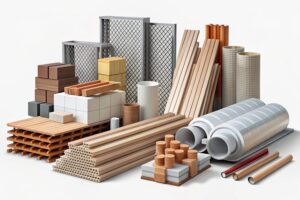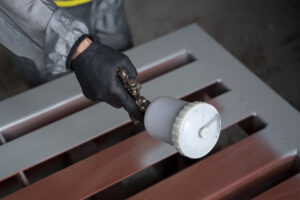
Home renovations bring excitement, new beginnings, and a fresh look to your living space. However, they can also introduce harmful chemicals into your environment, one of the most concerning being formaldehyde. This colorless, strong-smelling gas is often emitted by building materials, furniture, and other products used during renovations. Exposure to formaldehyde can cause a range of health issues, from minor irritations to serious respiratory problems. In this article, we will guide you on how to manage post-renovation formaldehyde in your home, ensuring a safer and healthier living space.
What Is Formaldehyde and Why Is It Dangerous?
Formaldehyde is a volatile organic compound (VOC) commonly used in building materials, adhesives, paints, and household products. It’s particularly prevalent in pressed-wood products like particleboard, plywood, and fiberboard, which are often used in home renovations. When these materials are new, they release formaldehyde gas into the air, a process known as off-gassing.
Post-renovation formaldehyde can linger in the air for weeks or even months, especially in poorly ventilated spaces. Short-term exposure to formaldehyde can cause symptoms such as eye, nose, and throat irritation, coughing, and skin rashes. Long-term exposure, particularly at higher levels, has been linked to more serious health issues, including respiratory problems, allergic reactions, and an increased risk of cancer.
Sources of Post-Renovation Formaldehyde
Understanding where post-renovation formaldehyde can come from is crucial for managing and reducing its presence in your home. Here’s a look at common sources of post-renovation formaldehyde:
Building Materials

Pressed-wood products are among the primary sources of formaldehyde in renovated spaces. These materials, including particleboard, medium-density fiberboard (MDF), and plywood, use formaldehyde-based resins and adhesives in their production. The off-gassing of formaldehyde is particularly high when these materials are new and may continue to emit the gas over time, although at a decreasing rate.
Insulation
Insulation materials can be significant sources of post-renovation formaldehyde. Urea-formaldehyde foam insulation (UFFI), used in older homes, is known for its high formaldehyde content. Though UFFI is less common today, some newer foam insulations and fiberglass batts still contain formaldehyde-based binders or adhesives. This can lead to long-term off-gassing, especially if the insulation is disturbed or improperly installed.
Paints and Coatings
 Paints, varnishes, and other coatings can contribute to post-renovation formaldehyde levels through their VOC content. Many traditional paints, especially those with higher gloss finishes, contain formaldehyde or formaldehyde-releasing compounds. These emissions can persist for days or weeks after application, particularly in newly painted areas that haven’t been ventilated properly.
Paints, varnishes, and other coatings can contribute to post-renovation formaldehyde levels through their VOC content. Many traditional paints, especially those with higher gloss finishes, contain formaldehyde or formaldehyde-releasing compounds. These emissions can persist for days or weeks after application, particularly in newly painted areas that haven’t been ventilated properly.
Furniture and Furnishings
New furniture and furnishings are significant sources of post-renovation formaldehyde. Items such as beds, sofas, and cabinets made from pressed-wood products or with composite materials can release formaldehyde. Carpets and rugs, especially those made from synthetic fibers or with formaldehyde-based adhesives, can also be sources of formaldehyde.
Household Products

Household products like cleaning agents, disinfectants, and personal care items can contribute to formaldehyde levels. Some cleaning products contain formaldehyde or formaldehyde-releasing preservatives (e.g. quaternium-15), which can release formaldehyde into the air over time. Even everyday items like nail polish, hair care products, and toiletries can contain formaldehyde or formaldehyde-releasing compounds, adding to the overall VOC load in your home.
How to Manage Post-Renovation Formaldehyde?
Managing post-renovation formaldehyde requires a proactive approach to reduce exposure and improve indoor air quality. Below are several strategies you can implement:
1. Increase Ventilation

One of the most effective ways to manage post-renovation formaldehyde is to increase ventilation in your home. Open windows and doors to allow fresh air to circulate and carry away airborne formaldehyde. Using fans or exhaust systems can also help to expel the gas from your indoor environment more quickly.
2. Use Air Purifiers with Activated Carbon Filters
Air purifiers equipped with activated carbon filters are excellent at capturing VOCs like formaldehyde. These purifiers work by adsorbing the formaldehyde molecules onto the surface of the carbon, effectively removing them from the air. When selecting an air purifier, ensure it’s designed to handle VOCs and has a sufficient capacity for the size of the room.
3. Choose Low or No-Formaldehyde Products
 When planning renovations or purchasing new furniture, opt for products labeled as low-formaldehyde, no-formaldehyde, or formaldehyde-free. These products are designed to emit significantly lower levels of formaldehyde compared to traditional options. Choose products that aligns with standards for formaldehyde emissions.
When planning renovations or purchasing new furniture, opt for products labeled as low-formaldehyde, no-formaldehyde, or formaldehyde-free. These products are designed to emit significantly lower levels of formaldehyde compared to traditional options. Choose products that aligns with standards for formaldehyde emissions.
4. Control Temperature and Humidity
Formaldehyde emissions are higher in warm and humid conditions. To manage post-renovation formaldehyde effectively, keep indoor temperatures and humidity levels in check. Use air conditioning or dehumidifiers to maintain a cooler and drier environment, which can slow down the release of formaldehyde. Ideally, indoor humidity should be kept below 50%, and temperatures should be kept moderate to minimize off-gassing.
5. Allow Time for Off-Gassing Before Occupying the Space
 After completing renovations, give your home some time to off-gas before fully occupying it. This is especially important if large amounts of new materials or products have been introduced. If possible, wait a few weeks before moving back in or using the renovated space. During this time, keep the area well-ventilated to facilitate the dissipation of formaldehyde.
After completing renovations, give your home some time to off-gas before fully occupying it. This is especially important if large amounts of new materials or products have been introduced. If possible, wait a few weeks before moving back in or using the renovated space. During this time, keep the area well-ventilated to facilitate the dissipation of formaldehyde.
6. Seal Formaldehyde-Emitting Surfaces
Sealing surfaces that emit formaldehyde can help to reduce off-gassing. Apply a layer of low-VOC sealant, varnish, or paint to the exposed surfaces of pressed wood products, furniture, and other potential sources. This creates a barrier that slows down the release of formaldehyde into the air. However, it’s important to use a sealant that is specifically designed for this purpose, as some sealants can contribute additional VOCs.
7. Consider Formaldehyde Absorbing Plants
Certain houseplants have been shown to absorb formaldehyde and other VOCs from the air, making them a natural way to manage post-renovation formaldehyde. Plants like spider plants, Boston ferns, and peace lilies are known for their air-purifying abilities. While plants alone won’t eliminate all formaldehyde, they can complement other methods and contribute to improving indoor air quality.
8. Regular Monitoring of Indoor Air Quality
 To ensure that your efforts to manage post-renovation formaldehyde are effective, consider investing in an indoor air quality monitor. These devices can detect formaldehyde and other VOCs, providing real-time data on the levels in your home. By regularly monitoring indoor air quality, you can take immediate action if formaldehyde levels rise, ensuring a safe and healthy environment.
To ensure that your efforts to manage post-renovation formaldehyde are effective, consider investing in an indoor air quality monitor. These devices can detect formaldehyde and other VOCs, providing real-time data on the levels in your home. By regularly monitoring indoor air quality, you can take immediate action if formaldehyde levels rise, ensuring a safe and healthy environment.
Conclusion
Managing post-renovation formaldehyde in your home is essential for maintaining a healthy indoor environment. By understanding the sources of formaldehyde, increasing ventilation, using air purifiers, selecting low-emission products, and taking other proactive measures, you can significantly reduce your exposure to this harmful gas. Remember, the key to managing post-renovation formaldehyde is to act quickly and stay informed about the materials and products you bring into your home. With these strategies, you can enjoy the benefits of your newly renovated space without compromising your health.
Let E³.SPACE bring your dream home vision to life. Book an appointment today.
